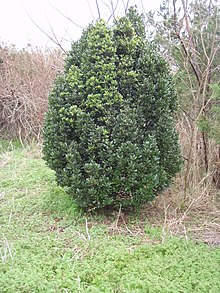Cassine laneana
| Cassine laneana | |
|---|---|

| |
| Scientific classification | |
| Kingdom: | Plantae |
| Clade: | Tracheophytes |
| Clade: | Angiosperms |
| Clade: | Eudicots |
| Clade: | Rosids |
| Order: | Celastrales |
| Family: | Celastraceae |
| Genus: | Cassine |
| Species: | C. laneana
|
| Binomial name | |
| Cassine laneana (A.H.Moore) J.Ingram[2]
| |
| Synonyms | |
|
Elaeodendron laneanum A.H.Moore.[3] | |
Cassine laneana, commonly known as the Bermuda olivewood, is a species of large tree in the staff vine family, Celastraceae, that is endemic to the islands of Bermuda. Although once found in the extensive subtropical coniferous forests that covered the islands, it is currently restricted to small protected areas, such as Spittal Pond.[4] C. laneana can grow anywhere from 25 to 40 feet (7.6 to 12.2 metres) tall, with leaves that are 1 to 2.5 inches (2.5 to 6.4 centimetres) long and 0.5 to 1.5 inches (1.3 to 3.8 centimetres) wide. The leaves are also a deep green colour when they are older and a bright green colour when they are younger. C. laneana flowers in late spring and early summer and produces a small ovate berry that is an olive colour and 0.25 to 0.5 inches (0.64 to 1.27 centimetres) long.
The Bermuda olivewood did not have very much use in Bermuda's history, although it played a huge part in it. It has huge boughs that are highly woody. The crown is naturally grown into a sphere shape. C. laneana is often used as an ornamental tree, lining the streets of Hamilton and providing shade in the Bermuda Botanical Gardens.
See also[edit]
Gallery[edit]
-
New planting for hedge row.
-
A new planting with a baby Bermuda cedar.
References[edit]
- ^ World Conservation Monitoring Centre (1998). "Elaeodendron laneanum". IUCN Red List of Threatened Species. 1998. Retrieved 2 October 2010.
- ^ "Celastraceae Cassine laneana (A.H.Moore ) J.Ingram". The International Plant Names Index. Retrieved 2 October 2010.
- ^ "Bermuda Olivewood (Cassine laneana syn. Elaeodendron laneanum)". Bermuda Department of Conservation Services. Archived from the original on 5 March 2010. Retrieved 2 October 2010.
- ^ World Wildlife Fund, ed. (2001). "Bermuda subtropical conifer forests". WildWorld Ecoregion Profile. National Geographic Society. Archived from the original on 8 March 2010. Retrieved 12 January 2009.
External links[edit]
![]() Media related to Cassine laneana at Wikimedia Commons
Media related to Cassine laneana at Wikimedia Commons
![]() Data related to Cassine laneana at Wikispecies
Data related to Cassine laneana at Wikispecies



